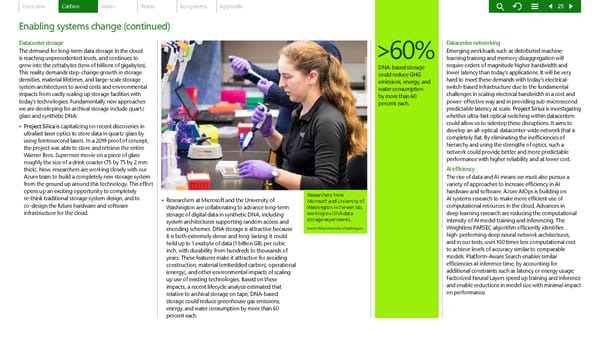Overview Carbon Water Waste Ecosystems Appendix 25 Enabling systems change (continued) Datacenter storage Datacenter networking The demand for long-term data storage in the cloud >60% Emerging workloads such as distributed machine- is reaching unprecedented levels, and continues to learning training and memory disaggregation will grow into the zettabytes (tens of billions of gigabytes). DNA-based storage require orders of magnitude higher bandwidth and This reality demands step-change growth in storage could reduce GHG lower latency than today’s applications. It will be very densities, material lifetimes, and large-scale storage emissions, energy, and hard to meet these demands with today’s electrical- system architectures to avoid costs and environmental water consumption switch-based infrastructure due to the fundamental impacts from vastly scaling up storage facilities with by more than 60 challenges in scaling electrical bandwidth in a cost and today’s technologies. Fundamentally new approaches percent each. power-effective way and in providing sub-microsecond we are developing for archival storage include quartz predictable latency at scale. Project Sirius is investigating glass and synthetic DNA: whether ultra-fast optical switching within datacenters • Project Silica is capitalizing on recent discoveries in could allow us to sidestep these disruptions. It aims to ultrafast laser optics to store data in quartz glass by develop an all-optical, datacenter-wide network that is using femtosecond lasers. In a 2019 proof of concept, completely flat. By eliminating the inefficiencies of the project was able to store and retrieve the entire hierarchy and using the strengths of optics, such a Warner Bros. Superman movie on a piece of glass network could provide better and more predictable roughly the size of a drink coaster (75 by 75 by 2 mm performance with higher reliability and at lower cost. thick). Now, researchers are working closely with our AI efficiency Azure team to build a completely new storage system The rise of data and AI means we must also pursue a from the ground up around this technology. This effort variety of approaches to increase efficiency in AI opens up an exciting opportunity to completely Researchers from hardware and software. Azure AIOps is building on re-think traditional storage system design, and to • Researchers at Microsoft and the University of Microsoft and University of AI systems research to make more efficient use of co-design the future hardware and software Washington are collaborating to advance long-term Washington in the wet lab, computational resources in the cloud. Advances in infrastructure for the cloud. storage of digital data in synthetic DNA, including working on DNA data deep learning research are reducing the computational system architectures supporting random access and storage experiments. intensity of AI model training and inferencing. The Weightless PARSEC algorithm efficiently identifies encoding schemes. DNA storage is attractive because Dennis Wise/University of Washington. it is both extremely dense and long-lasting: it could high-performing deep neural network architectures, hold up to 1 exabyte of data (1 billion GB) per cubic and in our tests, uses 100 times less computational cost inch, with durability from hundreds to thousands of to achieve levels of accuracy similar to comparable years. These features make it attractive for avoiding models. Platform-Aware Search enables similar construction, material (embedded carbon), operational efficiencies at inference time, by accounting for (energy), and other environmental impacts of scaling additional constraints such as latency or energy usage; up use of existing technologies. Based on these Factorized Neural Layers speed up training and inference impacts, a recent lifecycle analysis estimated that and enable reductions in model size with minimal impact relative to archival storage on tape, DNA-based on performance. storage could reduce greenhouse gas emissions, energy, and water consumption by more than 60 percent each.
 Microsoft Environmental Sustainability Report 2020 Page 24 Page 26
Microsoft Environmental Sustainability Report 2020 Page 24 Page 26